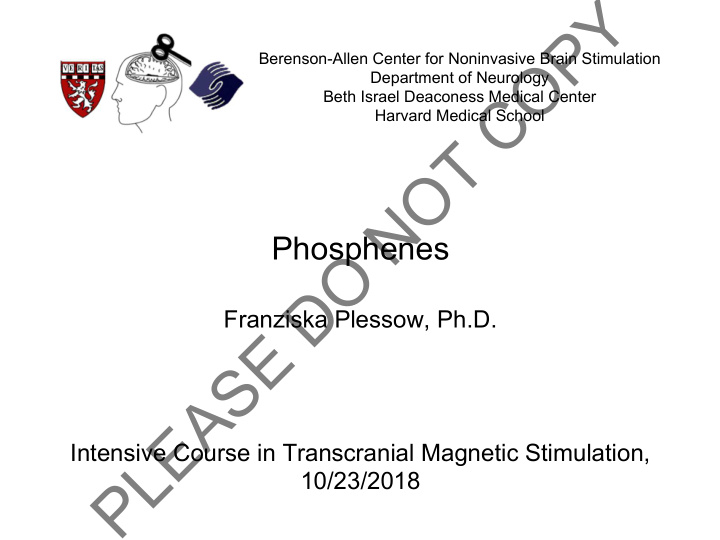



Y P O Berenson-Allen Center for Noninvasive Brain Stimulation Department of Neurology C Beth Israel Deaconess Medical Center Harvard Medical School T O N Phosphenes O D Franziska Plessow, Ph.D. E S A E Intensive Course in Transcranial Magnetic Stimulation, L 10/23/2018 P
Y P O Questions this session will answer C T 1. What are phosphenes? O 2. What characterizes TMS-induced phosphenes? N 3. When should you consider determining phosphene threshold? O 4. What are the key steps for determining phosphene D threshold? E S A E L P Phosphenes 2
Y P O What are phosphenes? C T § From Greek ph ō s ‘light’ + phainein ‘to show’ O § Brief visually perceived flashes of light triggered by N activation of neurons within V1 § Not caused by phototransduction but interpreted as visual O stimuli D E S A E L P Modified from Bear, Connors, & Paradiso, 1996 Phosphenes 3
Y P O How can phosphenes be elicited? C T § Mechanical stimulation O - Rubbing your eyes - “Seeing stars” from a blow to the head N - Pituitary tumor encroaching on optic chiasm O § Electrical stimulation D - Transcranial alternating current stimulation (tACS) - Transcranial magnetic stimulation (TMS) E S A E L P Phosphenes 4
Y P O What characterizes TMS-induced phosphenes? C T § Subjective experience O § Retinotopically organized N § Simple geometric shapes § Appear as light (in darkness or O eyes closed) D § Appear as blurring or scotoma E (eyes open) S A E L P From Marg & Rudiak, 1994. Optom Vis Sci Phosphenes 5
Y P O What characterizes TMS-induced phosphenes? C T § Subjective experience O § Retinotopically organized N § Simple geometric shapes § Appear as light (in darkness or O eyes closed) D § Appear as blurring or scotoma E (eyes open) S § Vary depending on level of A visual cortex stimulated E L P Phosphenes 6
Y P O When should you consider determining phosphene threshold? C T § To map the functional organization of the visual cortex O § To determine state-dependent stimulation effects N § To explore cortico-cortical interactions underlying visual attention and awareness O § To assess the relative excitability of the visual cortex to D determine procedural stimulation intensity E § To record a secondary index of cortical excitability in non- S motor regions A E L P Phosphenes 7
Y P O Relationship between motor and phosphene threshold C T O 0,75 Correlation (PT vs MT) N Phosphene Threshold (% MSO) 0,65 O 0,55 0,45 D 0,35 r 28 =0.29, p>0.1 r 16 =0.27, p>0.2 E 0,25 0,25 0,45 0,65 S Motor Threshold (% of MSO) From Gerwig et al., 2003. J Neurol Sci From Fried et al., 2011. PLoS One A E L P Phosphenes 8
Y P O Neural basis of phosphene awareness C T O N O D E S A E L P From Taylor et al., 2010. Hum Brain Mapp Phosphenes 9
Y P O What are the key steps for determining phosphene threshold? C T 1. Choosing a stimulation target (typically V1) O 2. Setting up and ensuring safety N 3. Locating the phosphene “hot spot” (adjusting location) 4. Assessing the phosphene threshold (adjusting intensity) O D E S A E L P Phosphenes 10
Y P O Setting up and ensuring safety C T O N O D E S A E L P Phosphenes 11
Y P O Locating the phosphene “hot spot” C T 1. Find the inion O 2. Mark point 2 cm superior and 2 N cm lateral 3. Orient coil with handle pointing O laterally: D Optimal current direction is lateral to medial in the brain E 4. Phosphene should be reported S in the contralateral visual field A E L P Phosphenes 12
Y P O Locating the phosphene “hot spot” C T 1. Set intensity to 30% and deliver 3 pulses (6-10 s apart) O 2. Go up in steps of 10% until phosphene is reported N 3. Deliver several pulses to ensure a consistent response (phosphene) is evident (suprathreshold) O 4. Construct and test a 5 x 5 cm grid around marked spot D - Deliver 3 pulses at each location E - Record phosphene incidence and vividness S 5. The location that elicits the most consistent, vivid, and A unambiguous phosphene is the phosphene “hot spot” E L P Phosphenes 13
Y P O Finding phosphene threshold C T 1. Record responses to 6 pulses O 2. Progressively lower intensity (1-2%) until occurrence <50% N 3. The lowest intensity that elicits a consistent, vivid, and unambiguous phosphene in ≥ 3/6 pulses is your O phosphene threshold D E S A E L P Phosphenes 14
Y P O Further considerations C T § Count only unambiguous responses (“yes” or “no”), O redo “maybe” N § Can be easier if subject is blindfolded (+ waiting time) § Have subject focus on center of visual field: O Directing attention to a part of the visual field will decrease threshold to D relative to rest of visual field E S A E L P Phosphenes 15
Y P O C T O Thank you for your active participation and good luck for the rest of the week! N O Email: fplessow@mgh.harvard.edu D E S ? A E ? L P Phosphenes 16
Recommend
More recommend